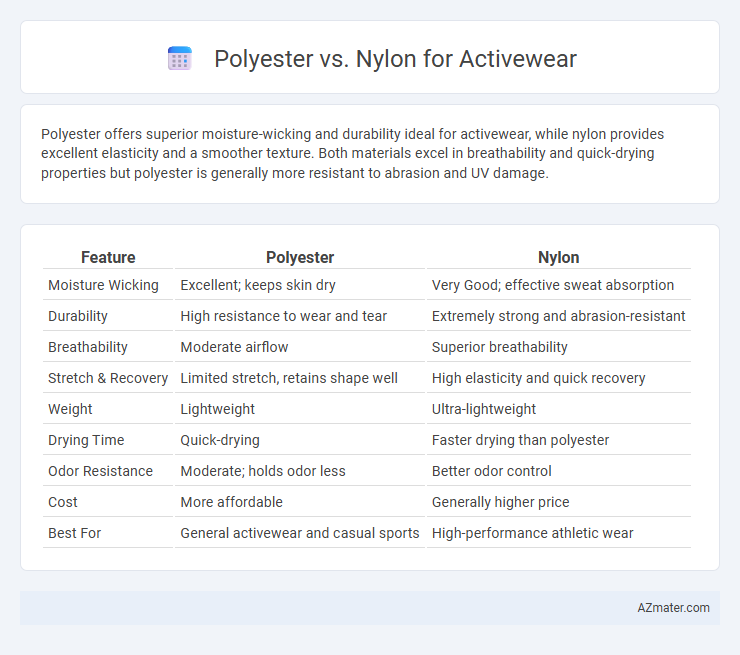Polyester offers superior moisture-wicking and durability ideal for activewear, while nylon provides excellent elasticity and a smoother texture. Both materials excel in breathability and quick-drying properties but polyester is generally more resistant to abrasion and UV damage.
Table of Comparison
| Feature | Polyester | Nylon |
|---|---|---|
| Moisture Wicking | Excellent; keeps skin dry | Very Good; effective sweat absorption |
| Durability | High resistance to wear and tear | Extremely strong and abrasion-resistant |
| Breathability | Moderate airflow | Superior breathability |
| Stretch & Recovery | Limited stretch, retains shape well | High elasticity and quick recovery |
| Weight | Lightweight | Ultra-lightweight |
| Drying Time | Quick-drying | Faster drying than polyester |
| Odor Resistance | Moderate; holds odor less | Better odor control |
| Cost | More affordable | Generally higher price |
| Best For | General activewear and casual sports | High-performance athletic wear |
Introduction to Polyester and Nylon in Activewear
Polyester and nylon are two of the most popular synthetic fibers used in activewear due to their durability and moisture-wicking properties. Polyester offers excellent resistance to shrinking and stretching, making it ideal for high-performance sportswear that requires shape retention and breathability. Nylon is known for its superior strength and elasticity, providing a smooth, lightweight feel that enhances comfort and flexibility during intense physical activities.
Material Composition and Structure
Polyester is a synthetic polymer made from polyethylene terephthalate (PET), characterized by its hydrophobic and durable fiber structure that offers excellent moisture-wicking and quick-drying properties ideal for activewear. Nylon, composed of polyamide fibers, features a tightly woven, smooth surface that provides superior elasticity, abrasion resistance, and lightweight comfort, making it suitable for high-performance athletic garments. The molecular alignment in polyester grants enhanced UV resistance, while nylon's crystalline fiber arrangement contributes to greater tensile strength and flexibility, impacting durability and fit in workout apparel.
Moisture-Wicking Properties Compared
Polyester excels in moisture-wicking due to its hydrophobic fibers that draw sweat away from the skin to the fabric's surface for quick evaporation, making it ideal for intense workouts. Nylon also offers good moisture management but tends to retain more moisture than polyester, which can result in a slightly damp feeling during prolonged activity. Both materials provide breathability and durability, yet polyester's superior moisture-wicking capacity often makes it the preferred choice for high-performance activewear.
Breathability and Comfort Levels
Polyester and nylon are popular materials in activewear, with polyester offering superior moisture-wicking properties that enhance breathability and keep the skin dry during intense workouts. Nylon provides a soft, smooth texture that increases comfort and offers excellent stretch for flexible movement. While polyester excels in durability and quick-drying capabilities, nylon's lightweight and breathable fabric often results in a more comfortable fit for prolonged wear.
Durability and Longevity
Polyester offers exceptional durability and resistance to abrasion, making it ideal for activewear that endures frequent washing and rough use. Nylon stands out for its superior tensile strength and elasticity, providing enhanced flexibility and resilience during intense physical activities. Both fibers boast long-lasting performance, but polyester maintains its shape and color better over time, contributing to greater longevity in activewear garments.
Stretch and Flexibility
Polyester exhibits moderate stretch and excellent shape retention, making it ideal for activewear that requires flexibility without losing form. Nylon offers superior elasticity and resilience, providing enhanced stretchability that supports a full range of motion during intense workouts. Both materials deliver moisture-wicking properties, but nylon's added stretch makes it preferable for applications demanding higher flexibility and durability.
Weight and Feel on the Skin
Polyester is lightweight and offers a smooth, soft feel on the skin, making it ideal for activewear that requires comfort during extended wear. Nylon tends to be slightly heavier but provides a silky texture with excellent stretch and durability, suitable for high-performance activities. Both fabrics are moisture-wicking, though polyester generally dries faster, contributing to a cooler, more breathable experience during intense workouts.
Odor Resistance and Hygiene
Polyester exhibits superior odor resistance in activewear due to its low absorbency and moisture-wicking properties that prevent bacterial growth, making it ideal for prolonged workouts. Nylon, while lightweight and durable, tends to retain more moisture, which can promote odor-causing bacteria and require more frequent washing to maintain hygiene. Choosing polyester activewear enhances freshness and reduces odor buildup, supporting better hygiene during intense physical activities.
Environmental Impact and Sustainability
Polyester and nylon dominate activewear fabrics, but their environmental impacts vary significantly. Polyester, made from petroleum-based products, contributes substantially to microplastic pollution and greenhouse gas emissions during production, though recycled polyester offers a more sustainable alternative. Nylon manufacturing also relies on fossil fuels and emits nitrous oxide, a potent greenhouse gas, yet innovations in bio-based nylons and closed-loop recycling processes are helping reduce its environmental footprint.
Choosing the Best Fabric for Your Active Lifestyle
Polyester offers excellent moisture-wicking properties and durability, making it ideal for high-intensity workouts requiring breathability and quick drying. Nylon provides superior stretch and softness with strong abrasion resistance, perfect for activities demanding flexibility and comfort like yoga or Pilates. Choosing between polyester and nylon depends on your specific active lifestyle needs, balancing durability, moisture management, and fabric feel.

Infographic: Polyester vs Nylon for Activewear
 azmater.com
azmater.com